
What is a Sailboat Boom Vang?

Last Updated by
Daniel Wade
June 15, 2022
A boom vang is a set of blocks and lines or an adjustable pole used to pull the boom down and shape the sail.
The boom vang (or “kicking strap”) is a system used to control the shape of the sail. It counteracts the upward force of the boom jack and the mainsail by pulling the boom downward. This results in the ability to control the shape of the sail.
Table of contents

Boom Vang vs. Mainsheet
What's the difference between the boom vang and the mainsheet? On many sailboats, the boom vang and the mainsheet look similar, as both use a set of blocks to control the motion of the boom.
The easiest way to tell the difference between the boom vang and the mainsheet is location. The boom vang typically begins close to the base of the mast and connects to the base of the boom at about a 45-degree angle.
The mainsheet is much further back and generally vertically-oriented. Sometimes, the mainsheet is located far at the end of the mast and connected to the stern of the vessel. Just remember boom vang forward, mainsheet aft.
What Does a Boom Vang Do?
A boom vang is a simple device consisting of a pole or a set of blocks and lines. The primary purpose of the boom vang is to control the vertical orientation of the boom and to exert a downward force on it.
Without the boom vang, the wind would blow the sail uncontrollably and make it difficult to maneuver efficiently. The mainsheet, which appears to exert downward pressure on the boom, wouldn't be able to adjust the sail effectively without a separate system like a boom vang.
Importance of the Boom Vang
A properly-adjusted boom vang becomes more important as you let out the mainsheet. The further from the centerline the boom travels, the less downward force the mainsheet provides.
This means that you'd lose a tremendous amount of control without a boom vang, especially as you loosen the sheet. A boom vang exerts a constant downward force on the sail regardless of what position the boom is in. This keeps the sail shape consistent in all conditions.
Boom Vang Types
There are two primary types of boom vangs used on sailboats today. The first and most common type is the standard boom vang. Standard boom vangs consist of a block and tackle arrangement that mounts to the base of the mast and bottom of the boom.
The second type is the hydraulic boom vang , which is more advanced and offers unique benefits. The hydraulic boom vang uses a hydraulic piston that looks like an oversized automobile shock or door opener.
The benefit of a hydraulic boom vang is that it holds the vertical position of the boom without assistance. It's rigid in both directions and doesn't require upward force to keep the boom in place.
Hydraulic boom vangs are costlier than traditional block-and-tackle setups. That said, they're easy to install and generally simple to operate. Hydraulic boom vangs are common on newer sailboats, especially those that exceed 30 feet in length.
What is a Boom Gnav?
A boom gnav is one of the most intuitive pieces of sailboat equipment. The word "gnav" is "vang" spelled backward, and it performs the exact same task on the opposite end of the boom.
A boom gnav exerts a downward force on the boom to counteract the upward force of the wind or rigging. A boom gnav pushes the boom down, whereas a boom vang pulls it down. Not all sailboats have a boom gnav, and those that do often use it as a substitute for a boom vang.
Boom gnav systems are most common on small sailboats , where the added lower triangle of a boom vang gets in the way. A boom gnav takes up no extra cockpit space as it mounts atop the boom and to a higher point on the mast.
In other words, the boom gnav operates within the sail area, which is a part of the boat that's already unusable due to the sail. A boom gnav is usually a pole that adjusts by sliding forward and aft on the boom, which changes the angle and downward force.
Boom Vang Maintenance
Maintenance is essential to keep your sailboat in safe and working condition, and the boom vang is no exception. There are a few boom vang parts you should inspect and maintain regularly.
Check the Mounting Points
The mounting points of the boom vang are subjected to a considerable amount of force, and they should be inspected regularly. Look for signs of corrosion (galvanic or otherwise) and bending.
If you notice any deformation, replace the mounting points and hardware with marine-grade hardware. Make sure the aluminum mast is solid, as corrosion can weaken the areas around the mounting holes.
Inspect Blocks and Tackle
For traditional boom vangs, regularly inspecting the blocks and lines can prevent problems down the road. Over time, nylon lines become salt and sun-damaged and begin to fray. If the lines are brittle and leave excessive dust on your hands, it may be time to replace them.
Blocks are generally reliable and don't require a significant amount of maintenance. That said, you should inspect your blocks and make sure they spin freely. If they don't (or they become too loose), they could be failing and should be replaced with high-quality marine blocks.
Hydraulic Boom Vang Maintenance
Hydraulic boom vangs are simpler than traditional block and tackle setups, but they still require regular inspection. A hydraulic boom vang uses a piston and a working fluid instead of lines and pulleys.
On hydraulic boom vangs, the primary failure points are the seals and the mounting points. If your boom vang begins to leak, you'll notice a decrease in stability, and the vang won't hold tension.
Another common failure point is the spring, which can weaken or break and make the vang almost unusable. In most cases, the best option when your hydraulic boom vang fails is to replace it entirely.
What is a Boom Jack?
A boom jack (also known as a lazy jack) is the rigging that exerts an upward force that the boom vang or boom gnav counteracts. The boom jack begins at the boom and reaches up to the top of the mast.
Boom jacks resemble any other rigging on a sailboat. They roughly form the triangular shape of the sail and usually mount to the boom at multiple points.
A typical boom jack begins as a single line at the top of the mast. About 1/4 of the way down the mast, it splits into two lines. At the halfway point, each end of the two lines splits again into four. These four lines run down to the boom and mount evenly-spaced apart.
The purpose of the boom jack is to exert even upward force on the boom. The tension of the boom jack is set as to counteract the tension of the boom vang, which holds the boom at a steady 90 degrees. The boom jack line runs down from the top of the mast to a block or cleat on the opposite end of the boom vang.
Adjusting the Vang
Generally speaking, the boom vang isn't as important when traveling upwind as it is when traveling downwind. This is especially true once you've maxed-out your mainsheet traveler.
At this point, the vang controls the twist of the mainsail. With an improperly-adjusted vang (or lack thereof), you could experience a lot of up-and-down play of the boom. This can cause you to lose control of the mainsail.
A properly-adjusted boom vang can help you keep your mainsail shaped correctly and keep your boom in the proper position. It also gives you precise control of your speed when traveling downwind.
Related Articles
I've personally had thousands of questions about sailing and sailboats over the years. As I learn and experience sailing, and the community, I share the answers that work and make sense to me, here on Life of Sailing.
by this author
Sailboat Parts
Learn About Sailboats
Most Recent

What Does "Sailing By The Lee" Mean?
October 3, 2023

The Best Sailing Schools And Programs: Reviews & Ratings
September 26, 2023
Important Legal Info
Lifeofsailing.com is a participant in the Amazon Services LLC Associates Program, an affiliate advertising program designed to provide a means for sites to earn advertising fees by advertising and linking to Amazon. This site also participates in other affiliate programs and is compensated for referring traffic and business to these companies.
Similar Posts

Affordable Sailboats You Can Build at Home
September 13, 2023

Best Small Sailboat Ornaments
September 12, 2023

Discover the Magic of Hydrofoil Sailboats
December 11, 2023
Popular Posts

Best Liveaboard Catamaran Sailboats
December 28, 2023

Can a Novice Sail Around the World?
Elizabeth O'Malley

4 Best Electric Outboard Motors

How Long Did It Take The Vikings To Sail To England?

10 Best Sailboat Brands (And Why)
December 20, 2023

7 Best Places To Liveaboard A Sailboat
Get the best sailing content.
Top Rated Posts
Lifeofsailing.com is a participant in the Amazon Services LLC Associates Program, an affiliate advertising program designed to provide a means for sites to earn advertising fees by advertising and linking to Amazon. This site also participates in other affiliate programs and is compensated for referring traffic and business to these companies. (866) 342-SAIL
© 2024 Life of Sailing Email: [email protected] Address: 11816 Inwood Rd #3024 Dallas, TX 75244 Disclaimer Privacy Policy
Wiktionary.org offers this defintion of the word vang .
Although the etymology is all very interesting. The latter is the one we are the most interested in. Below is a good video describing the benefits of the boom vang and when to use it.
[youtube https://www.youtube.com/watch?v=C31nGzO54O4&w=560&h=315]
The Boom Vang , in its simplest form, is a block and tackle arranged in such a fashion that it applies downward force (also upward force, see rigid vang) to the boom. This will allow the sailor to control the tension of the leech at all points of sail, regardless of the boom’s sheet tension.

RIGID VANGS – Most modern day cruisers and racers alike will use a version of this called a rigid vang. A rigid vang, a.k.a. hard vang, or boom kicker, gets its name because it not only is able to haul the boom down but also pushes it up. This is very handy for a few reasons. The ‘main’ reason (pun intended) is it allows the user a quick way to de-power the booms sail if needed and also helps to support the boom much like a boom topping lift. The last part makes reefing, dousing and storing of the boom all a bit easier.
In taking a look at who’s making these rigid vang systems we find no shortage in manufacturers: Boom Kicker , Barton Boom Strut , Bamar Rigid Vang , US Spars/Z Spar Vang , Selden Rod Kicker , Hall Spars Quick Vang , Vang Master , Forespar Yacht Rod , and Sparcraft Vang . Those are just the mechanical vang makers of the world (and I’m sure I’ve missed some).
On the hydraulic end of things, there are far less manufacturers. If your boat is already equipped with a hydraulic system of any kind you’ll likely recognize one of these brands: Navtec , Sailtec , Selden , and Harken , which are all makers of high quality hydraulic systems…including vangs.
Let us just focus on the ones that we know best and sell the most of here at The Rigging Company!

Forespar Yacht Rod is a tried and true system and our most popular model yet. It may not be the lightest or sleekest out there, but this vang has earned it’s rank among one of the most dependable in the rigid vang market. It is well suited for just about any racer/cruiser or dedicated cruising boat out there. The yacht rod uses a dependable coil spring as the return. Forespar vangs are adjustable, utilizing a very coarse adjustment (about every 4″) via a fast pin which allows the user a tool-less way to adjust the spring pre-load or boom kick height. The vang is constructed of one smaller anodized aluminum tube and one larger painted aluminum tube with cast anodized ends. Pricing is around the $870 – $1600 range, and they are available in just 3 different sizes. Mast brackets, block and tackles, boom lugs, all sold separately.

Hall Spars Quick Vang has also been around for a long time. Although Hall USA has recently announced its closing of business , I think shoppers will still find an inventory of these super high quality vangs with various distributors throughout the US. The Hall Spars Quick Vang has always had a great reputation, and their most recent iteration is even better. Typically, this vang is found on racer/cruisers and dedicated racing boats. Although there is no reason this couldn’t be found on a cruising boat in my opinion. This vang also offers a coil spring as the return mechanism. The springs pre-load can be finely adjusted to set the boom’s kick height (hex keys required). It consists of completely anodized aircraft grade aluminum tubing with solid aluminum machined ends. These systems can vary in price from $1000 to $2800 and are available in 7 different sizes/configurations. Purchase block and tackles are always included, varying from 8:1 to 60:1 depending on boat size and sail requirements. As with all of these systems, mast brackets and boom lugs are purchased separately.

Selden Rodkicker vangs have also been around a very long time and are rigged on many different styles of boats. It is likely they are equipped on more boats than any of the other manufacturers, from the club racer/cruiser, to the dedicated match racer, to the varying ranges of production cruising boats found in today’s sailboat market. Selden’s approach is slightly different in that it uses a gas spring (much like your gas strut on your hatchback) as the return. They also use a very attractive rectangular extrusion instead round tubing like Forespar and Hall. Selden’s Rodkicker vang does not offer any spring height adjustment. The ends are made of cast anodized aluminum (like Forespar). Price wise these are some of the most affordable systems on the market, ranging from just under $300 up to $1600 (hence their popularity). The Selden vangs come in 4 different sizes, and offer a soft and hard spring option within each size (they also offer the no spring option, but what’s the point? ). Purchase block and tackles, mast and boom brackets must be bought separately.

Hydraulic Vangs – Amongst the various hydraulic vang manufacturers you will see very similar design, functionality, and construction. It seems that Navtec, who also recently closed their doors , was the grandfather of all sailboat hydraulic system and cylinder design. The three big players left (see links at the top of this article) all have their own unique features and benefits, but are for the most part based on the same (Navtec) design. Whether we are talking about a double acting push pull vangs (reserved primarily for larger yachts with heavy booms) or gas return vangs, the gist is the same. There is a stainless steel piston rod with an aluminum piston that rides inside of an anodized aluminum cylinder/body. This is all accompanied by a series of seals that will need to be serviced/replaced once in while to keep things….sealed. The big deal is that all of these hydraulic vangs require the boat to be plumbed with hoses, a reservoir and a control panel that houses the pressure gauge and pump at a minimum. Besides just a basic vang cylinder (no plumbing, brackets, lugs or panels) costing as much as the most expensive mechanical vang mentioned above, these systems HAVE to be professionally installed thus making them the most expensive, but also the most robust option, by far.
~Some Final Thoughts~
All rigid vangs especially when properly installed and maintained will last a very (very) long time. Keep in mind, typically anything using fluid (and or gas) and seals will require service/ repair over time. One thing that all vangs require, regardless of whether choosing a simple block and tackle, mechanical, or hydraulic system, is for them to be installed properly; ensuring a properly mounted mast bracket and boom lug, rigging the vang in the correct orientation (not upside down), all the while achieving the appropriate boom to vang angle (approximately 30-45 degrees). This will ensure functionality, longevity and ease of use.
Have a question about which system might be right for you? Need your hydraulic vang serviced? Talk to our experienced sales staff for more information.
Thanks for the read. See you next time.
Similar Posts
Imagine crossing the Atlantic on one of these…………by yourself. Surfs Up! [youtube http://www.youtube.com/watch?v=l75CcGpcYjc&w=560&h=315] Brought to you by SailingNewsTV’s YouTube feed.
Views from Aloft
A beautiful tucked away spot in one of Annapolis’ many waterfront hiding spots. Any guesses where this might be? (click the image for a larger view) We conducted a rigging survey on a Catalina 36. Look there is my puppy dog Sidney, wondering ‘what in god’s green earth’ am I doing up there. ……and hey there’s Sean, Hi Sean ;-0)…
Super Yacht Challenge
Sometimes it is polite to stare………… ……at Beautiful Yachts! Click this link and get the down low for the regatta next year, it will be quite the event. This is a shot of the beautiful, 180 footer, Marie.
A French Icon…..
…….The Amel 55, is a true luxury blue water cruiser, well built and very…….Amel. [youtube http://www.youtube.com/watch?v=FgyUTORwKIc&w=560&h=315] This video was brought to you by the hard working fellows at YachtingWorld’s YouTube Channel. I love the enclosed helm with the large windows. A truly gorgeous yacht!
Check Out The New Hydroptère…….
……. doing some practice in the San Francisco Bay to prepare for the crossing of the Pacific. The freshly painted, newly sponsored DCNS Hydroptère, the boat that flies, has recently been delivered from France to the west coast of America to attempt to beat the Trans-Pacific World Record. This record should get smashed considering the boat’s speed. I am…
Antarctica is Beautiful
I found this on YouTube and found it quite relaxing…….even the cheesy elevator music. This is a beautiful boat and a beautiful sailing destination. Although this isn’t the typical warm tropical paradise it is definitely on my list of places to visit. Enjoy. [youtube http://www.youtube.com/watch?v=WliDLjg5CDg&w=560&h=315]
Leave a Reply Cancel reply
Your email address will not be published. Required fields are marked *
Save my name, email, and website in this browser for the next time I comment.
Hi, I am chasing a vang for my Cape 35 that supports the boom. Eye to eye for the band is 1700mm. Cheers, John.
We’d be glad to help. Any vang from any of the manufacturers listed in the article should work. Although some have different pin to pin measurements, most are adjustable, and are about the same for the given size unit. Can you send us pictures of what you have now for a boom and a mast attachment? Email [email protected] . Is there a specific manufacturer that you might prefer based on the article? Let us know in an email and we can set you up a complete DIY solution with instructions after we answer a few questions.
Thanks for Choosing…
Greetings, looking for a Hall Spars cast aluminum vang boom lug to replace mine which deformed and failed. It attaches to the underside of the boom with eight 5/16″ machine screws. Older model which came with a 1988 Sabre 38 MkII. Thank you.
Hey Carter, Thanks for contacting us, it took me a while and we’re super busy, but I have some info….
For the boom portion there are still parts available. Pricing is coming your way, but first let me know which on you need the externally mounted one one internally mounted one.
Use [email protected] to let us know which you would like and we’ll will get pricing and ship one out to you.
Thanks and We Hope that Helps, ~T.R.C.
Hi there, thanks for the reply. It’s an external lug with 8 fasteners. Here’s a photo:
https://www.dropbox.com/s/uicq8ctizs3eoyg/20180603_172037.jpg?dl=0
$219 in stock. Give us a call and we’ll get one shipped to you.
I am trouble shooting a Navtec boom vang. Vang does not pressurize. Trying to determine if the cylinder seals need replacing or the actual vang seals.
My advice is that if the cylinder is not holding pressure, you just re-build the entire unit and re-charge the return. Then we test the unit overnight. There are complete seal kits available for this. We recommend professional certified service to do this. Please let us know if we can help further.
Username or Email Address
Remember Me
Lost your password?
Review Cart
No products in the cart.

- Privacy Overview
- Strictly Necessary Cookies
This website uses cookies so that we can provide you with the best user experience possible. Cookie information is stored in your browser and performs functions such as recognising you when you return to our website and helping our team to understand which sections of the website you find most interesting and useful.
Strictly Necessary Cookie should be enabled at all times so that we can save your preferences for cookie settings.
If you disable this cookie, we will not be able to save your preferences. This means that every time you visit this website you will need to enable or disable cookies again.
- New Sailboats
- Sailboats 21-30ft
- Sailboats 31-35ft
- Sailboats 36-40ft
- Sailboats Over 40ft
- Sailboats Under 21feet
- used_sailboats
- Apps and Computer Programs
- Communications
- Fishfinders
- Handheld Electronics
- Plotters MFDS Rradar
- Wind, Speed & Depth Instruments
- Anchoring Mooring
- Running Rigging
- Sails Canvas
- Standing Rigging
- Diesel Engines
- Off Grid Energy
- Cleaning Waxing
- DIY Projects
- Repair, Tools & Materials
- Spare Parts
- Tools & Gadgets
- Cabin Comfort
- Ventilation
- Footwear Apparel
- Foul Weather Gear
- Mailport & PS Advisor
- Inside Practical Sailor Blog
- Activate My Web Access
- Reset Password
- Pay My Bill
- Customer Service

- Free Newsletter
- Give a Gift

How to Sell Your Boat

Cal 2-46: A Venerable Lapworth Design Brought Up to Date

Rhumb Lines: Show Highlights from Annapolis

Open Transom Pros and Cons

Leaping Into Lithium

The Importance of Sea State in Weather Planning

Do-it-yourself Electrical System Survey and Inspection

Install a Standalone Sounder Without Drilling

When Should We Retire Dyneema Stays and Running Rigging?

Rethinking MOB Prevention

Top-notch Wind Indicators

The Everlasting Multihull Trampoline

How Dangerous is Your Shore Power?

DIY survey of boat solar and wind turbine systems

What’s Involved in Setting Up a Lithium Battery System?

The Scraper-only Approach to Bottom Paint Removal

Can You Recoat Dyneema?

Gonytia Hot Knife Proves its Mettle

Where Winches Dare to Go

The Day Sailor’s First-Aid Kit

Choosing and Securing Seat Cushions

Cockpit Drains on Race Boats

Rhumb Lines: Livin’ the Wharf Rat Life

Re-sealing the Seams on Waterproof Fabrics

Safer Sailing: Add Leg Loops to Your Harness

Waxing and Polishing Your Boat

Reducing Engine Room Noise

Tricks and Tips to Forming Do-it-yourself Rigging Terminals

Marine Toilet Maintenance Tips

Learning to Live with Plastic Boat Bits
- Sails, Rigging & Deck Gear
Solid Vang Showdown
Vang master pushes to the top; steer clear of the ocean vang.
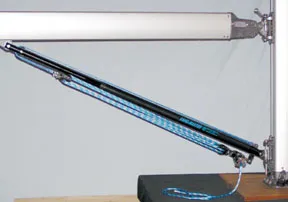
]It’s been more than six years since Practical Sailor evaluated rigid boom vangs. Given the rapid evolution of sailing hardware, it’s high time we take another close look.
In that May 15, 1999 report, we wrote that Hall Spars and Rigging’s QuikVang was the best all-around product, if you were game to ignore prices. Garhauer Marine’s vang was our Best Buy due to its rugged construction and economical price, and Spinlock’s then new Powervang was the product of choice for the racing set. If you owned a larger boat and wanted a lightweight vang, your best bet was Selden’s Rodkicker. As that 1999 test indicated, determining the appropriate rigid vang for your boat and your style of sailing is not a one-size-fits all affair. The process is fraught with conditional answers that only you can supply.
First, you have to determine if you want a rigid vang primarily for supporting your boom. If that’s the case, then the performance of the vang may be less important to you than the cost and the product’s purported longevity. If you want a vang that will allow you to make fairly precise refinements to your mainsail trim as well as support your boom, you’ll be looking more closely at how easy it is to adjust and its range of adjustability. Then, you have different types. Do you favor a spring-loaded, gas-cylinder, pneumatic, or rod vang?
Our evaluation included all four types. It’s important to note that you shouldn’t install a rigid vang on a boom that rotates, as this will compromise the gooseneck fittings on the vang or the boom itself. Also, standard, off-the-shelf rigid vangs like the ones PS evaluated here are not suitable for use with in boom furling. For those applications, you’ll want heavier duty equipment.
The Test For this test, PS amassed a group of eight rigid vangs from seven manufacturers. We asked each company to send a vang that would be suitable for a 36-foot sloop with a 13-foot boom. We told them that we were upgrading from a 4:1-purchase soft vang, that our objectives were convenience and safety, and stipulated that there were no suitable fittings on the mast or boom for attaching the new vang. We also mentioned that the mainsail on this boat weighed 50 pounds, and we described the spars as having rectangular grooves for the attachment fittings.
Selden Masts, which manufactures three different sizes of the Rodkicker, loaned us a mast and boom display mounted on a pallet, and we used this as a test platform for each vang. We looked closely at the vangs as well as the mounting fittings, which can vary according to the type of spar you have. We operated each vang multiple times and examined the construction quality, noted the stroke range, maximum return force, as well as the ease of use, and overall weight.
Vang Master Marine Products Engineering is a small manufacturing firm based in San Pedro, California, that also builds pneumatic actuators for doors, lids, and some other applications. Proprietor and designer Doug Grant has been building vangs for 14 years, and he is the supplier for Melges Boatworks and Ultimate Sailboats. His Vang Masters range in size from from 24 inches to 9 feet.
Grant uses 6061 T6 aluminum tubing that is hard-coat anodized and impregnated with Teflon. The end fittings are also machined from aluminum and hard-coat anodized. Except for the sheave and jaw attachment pins, MPE doesn’t use any stainless steel. These vangs operate with an 8:1 cascading purchase system using Harken blocks (including a ratchet block and cam cleat), the last part of which runs through a sheave in the upper end of the vang.
Grant says he presets the cylinder pressure on each vang, but he also includes a bicycle pump so that an owner can make his own adjustments. To change the pressure, you simply pump the vang up to whatever pressure you need to keep the boom level.
The lightest vang, the Vang Master also provided the smoothest action. This was surprising, because others like the Hall QuikVang or those from Garhauer come with greater mechanical advantage. The Vang Master VM-4 offers 16 to 18 inches of stroke range with up to 500 pounds of return force, and comes with a four-year warranty that covers any breakage under normal use. It sells for $845, including the pump, but not the end fittings ($110 for the boom, $145 for the mast).
Garhauer Marine Known for its rugged, if heavy, products, Garhauer Marine provides deck hardware for Catalina Yachts. The company supplied two vangs for our test: the RV20-1SL with a stainless outer tube, and the deluxe RV20-1AL, with a 6061 T aluminum outer tube, integrated purchase fittings, and a larger aluminum sheave in the head. Both vangs are intended principally to support the boom and both rely on 1½-inch diameter stainless steel springs — four in each case — to offer the resistance.
Garhauer includes in its price custom mast and boom fittings that are polished, beefy 316 stainless pieces with finely welded or machined components. The vangs featured similarly rugged construction. Except for the composite sheaves built into the vangs’ forked ends, all the sheaves in the 20:1 purchase are anodized aluminum, which spin on Torlon ball bearings.
These vangs have a wide stroke range — 8 to 12 inches — and they reliably returned our boom to the same position. Their construction appears to be bullet-proof (they carry a 10-year warranty) and they have the lowest prices of any vangs that passed our test ($374 for the RV20-1SL, and $429 for the duluxe RV20-1AL, including end fittings). Yes, they’re also the heaviest products, but not by much. Their main disadvantage is that, once they are installed, the resting height is not as adjustable as it is in other vangs.
Forespar Forespar’s Yacht Rod is made of a polished stainless steel inner tube and an Awl-Grip coated aluminum outer tube, and anodized aluminum forked ends. The Yacht Rod uses a single stainless steel spring for resistance. It’s marketed as both a device for supporting the boom and for trimming the sail in cruising or racing applications.
The Yacht Rod, which is built in three sizes, has a 4:1 tackle using Harken fiddle blocks and 7/16” line. A section of Spectra line attaches to that and runs through an aluminum sheave in the upper end’s fork to create an 8:1 purchase.
Forespar offers several sizes of mast and boom end fittings for its Yacht Rods (sold as part of the package or separately). The majority of these are fashioned from polished stainless steel. The welds on the fittings that were sent to PS were solid and well executed.
The outer tube has four holes at four-inch increments that accept a fast pin to adjust the boom’s height and allow a wide range of resting positions. This would be a handy feature to temporarily lift the boom in order to raise or lower a dodger or bimini. Forespar’s otherwise excellent installation instructions lacked a detailed drawing of the mast end, which would be a big help.
This vang was simple to install and operated fairly smoothly, but the spring did squeak slightly when compressed. The medium-size Yacht Rod has a stroke range of 7 inches, and provides 600 pounds of return force. It comes with a warranty of three years and sells for $873, including the tackle and end fittings.
Hall QuikVang Roughly five years ago, Hall Spars introduced the pneumatic QuikVang 2000, but, citing “complexities with its use,” has stopped production. Hall plans to introduce a new vang, which we’ll test and present in a future issue. For this evaluation, we looked at the conventional
QuikVang, a top performer in previous tests, and a product that Hall has been building for 20 years.
Marketed principally as a sail-trimming device, the QuikVang has anodized aluminum tubing and end fittings as well as a stainless steel spring. A Delrin plug in the inner tube acts as a piston to compress the spring when the 18:1 purchase system is tensioned. Delrin sleeves between the two tubes reduce friction and snug tolerances between the spring and the outer tubing keep the spring in column. Once installed, you can adjust the vang’s resting height in one-inch increments by loosening the set screws on the adjuster knob.
The purchase system features Harken blocks and Yale Dacron braided line, and includes a ratchet block and cam cleat so you don’t need any additional deck hardware for basic operation. Three parts of the purchase use stainless wire over aluminum sheaves, which are mounted in the jaws of the vang. Hall’s end-fittings are machined from aluminum and then hardcoat anodized.
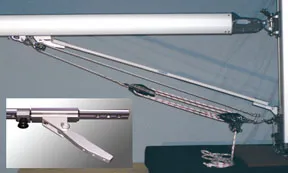
The QuikVang was easy to install and adjust. It operated smoothly and reliably returned the boom to its initial position. One convenient feature is a ratchet that lets you release the control line under heavy load. And Hall’s booklet of instructions is very complete, including information on installation, operation, and maintenance. This model has a stroke range of 6 inches, 600 pounds of return force, comes with a three-year unconditional warranty, and sells for $906, not including end fittings.
Seoladair’s Boomkicker Seoladair, a small manufacturing firm just outside of Chicago, IL, produces stowable fenders, rolling boom bales, and the Boomkicker. This product is simple and will suit owners who want something to support their boom and work in tandem with an existing soft vang.
The Boomkicker, which is sold in five sizes for boats from 14 to 38 feet, is simply a set of fiberglass rods. The rods are held captive at either end with hardcoat anodized aluminum collars and attach to the mast and boom via durable, machined and anodized aluminum fittings. Users can further customize the Boomkicker by cutting the rods to a shorter length.
PS found the Boomkicker simple to install and easy to use. The 1500 we tested came accompanied by a 4:1 tackle using Harken blocks (and cam cleat) as well as a short section of Spectra run through an additional block to create an 8:1 purchase. Also included was an aluminum attachment tang for the purchase system, as well as a drill bit, stainless fasteners, and a tap to secure the fittings to the boom. (In most cases, the mast fitting uses the luff groove for attachment and no drilling or tapping is necessary.) At 4.5 pounds, the Boomkicker is the lightest in this test. The model we tested offers 600 pounds of return force with a stroke range of up to 16 inches, and carries a five-year warranty. It sells for $309, not including tackle, which we found for $173.
Last year, Seoladair introduced a new sliding boom fitting, which includes a 16-inch section of aluminum track and a car for the upper end. Without this, the Boomkicker drop outs out of the boom when it’s raised well above horizontal. This is to prevent overloading of the fittings. We’d definitely shell out the extra $108 for the new boom fitting.
Selden’s Rodkicker Selden’s Rodkickers come in four sizes for boats from 22 to 60 feet and use gas-pistons for their return force. These pistons are mounted inside rectangular anodized aluminum extrusions that are mated to anodized aluminum end-fittings secured with Monel rivets. This vang came with an external 4:1 block and tackle using Rutgerson fiddle blocks with a cam cleat, which Selden sells as an option. The tackle connects to a large stainless wire that runs over a composite sheave integrated into the vang’s upper end fitting, creating an 8:1 purchase.
We tested the Rodkicker 20, which is rated for boats from 35 to 42 feet. To specify its vangs, the company first looks at righting moment and rig type, and thereafter considers the weight of the boom and sail. The Rodkicker 20 claims a stroke range of seven inches and a return force of 876 pounds using the normal gas piston. The inner extrusion is capped by a composite plug, which acts as a bushing.
It took PS testers about 20 minutes to read the instructions and assemble the Rodkicker 20, which arrived in three boxes. It mounted easily to the machined boom (aluminum) and mast (stainless steel) fittings that the company supplied. The first time we used it, this vang took the most force (roughly 60 pounds) to compress, but it operated smoothly after that. Bernie Beasley at Selden told us that operation of each vang relies on the weight of a full boom and sail resting on it. With that factored in, he said, we wouldn’t have experienced as much initial resistance.
Selden offers a two-year warranty on the Rodkicker. The 20 sells for $685, not including tackle. We were impressed by several aspects of this vang. Where clevis pins are used to connect the vang to the boom and mast, the end fittings have recesses to keep the cotter pins from sticking out and doing damage. And the boom fitting uses three Allen screws for attachment. These can either be tapped into the spar or dogged down for compression attachment. Selden also offers a universal boom bale for booms without an integral track.
Sparcraft Based in France, Sparcraft has manufacturing facilities for mast, booms, and rigging systems there and in the United States at Charleston Spars in Charlotte, North Carolina. The Ocean Vang uses anodized aluminum tubes that compress a stainless steel spring by way of an external 4:1 purchase system to deliver a return force of 300 pounds The vang has sheaves integrated into its end fittings, and there are no external blocks, which simplifies the arrangement, but limits the amount of purchase available. (Some vangs are sold with additional external tackle.) The polished, 316 stainless-steel brackets for mast and boom come in various sizes and configurations.
Installation was simple and straightforward, which was good because the vang arrived with no instructions. You’ll need to lead the the control line to a swiveling, pivoting block mounted on deck because the sheaves in the vang don’t articulate and the line won’t otherwise lead in a fair fashion when the boom is off centerline.
PS found two problems with the Ocean Vang. Its spring was squeaky and it didn’t regularly return the boom to its initial point after we installed it. When we opened the unit, we found that the design doesn’t keep the spring in column. When the spring moves off-center — as is almost certain to occur any time the spring is under load — the spring rubs directly on the outer tube, producing friction and squeaking. We applied some WD 40 and the vang worked more smoothly and squeaked less, though it still didn’t perform satisfactorily.
Jim Kulibert, Charleston Spars’ director of sales, told us that our experience was an anomaly. He says the company has furnished hundreds of these vangs to boats over the years and they never receive complaints of squeaks or binding.

This size Ocean Vang retails for $279, which includes the control line, but not the brackets for the mast ($39) or boom ($42). The vang carries a one-year warranty.
Conclusions For cruising sailors, it’s most important that a rigid vang works to support the boom and secondarily to trim the mainsail. If simple support is what you’re after, almost all of these products are suitable. Factor in ease of operation, and you can whittle that group down by excluding the Sparcraft’s Ocean Vang, which we have given a Don’t Buy rating.
If post-installation adjustment is the next criterion, you can overlook the vangs from Selden and Seoladair, which worked perfectly well in all other aspects. So, you’re left with our selection of vangs from Garhauer, Forespar, Hall, and Marine Products Engineering (the Vang Master). The Garhauers offer limited adjustment pre-installation, the
Yacht Rod adjusts in 4-inch increments, the QuikVang in 1-inch increments, and the Vang Master’s range is virtually unlimited.
If you want a basic rigid boom vang that is well built and functions smoothly for the least dollar outlay, Garhauer is the clear choice. Astoundingly, these rugged vangs are about half the price of those from the other builders, and with a 10-year warranty, they are hands down our Budget Buy.
If you are interested in a smoothly operating vang that you can use to reliably control your mainsail, those from Forespar or Hall fit the bill and earn our Recommended rating. But of all the vangs, the Vang Master from Marine Products Engineering has the best adjustability, the smoothest operation, the longest stroke range, and the longest warranty of these three, and thus, even with it’s high pricetag, it is our Best Choice overall.
Also With This Article “Vang Types” “PS Recommended” “PS Value Guide: Boom Vangs”
RELATED ARTICLES MORE FROM AUTHOR
What issue did this article appear in?
The prices in this article are from 2006 /2019?? I’m interested in the Garhauser vang but see only these vangs and prices: Rigid Boom Vang RV20-1 DX => $679.80 Rigid Boom Vang RV20-1 SL => $599.50
LEAVE A REPLY Cancel reply
Log in to leave a comment
Latest Videos

Island Packet 370: What You Should Know | Boat Review

How To Make Starlink Better On Your Boat | Interview

Catalina 380: What You Should Know | Boat Review
- Privacy Policy
- Do Not Sell My Personal Information
- Online Account Activation
- Privacy Manager
Do I Really Need a Boom Vang?
We get a lot of great questions through our Ask the Expert portal and sometimes they make for great articles. Here are Quantum's David Flynn's insights for Mark A. and everyone else who's wondered about how to properly use the boom vang.
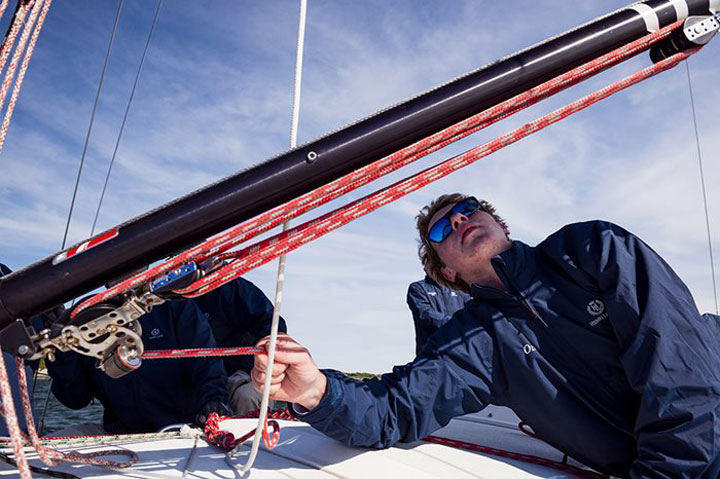
I’ve barely ever used my boom vang. Do I really need one?
Absolutely! The boom vang can be a misunderstood sail control. It takes over the job of pulling down on the boom once the mainsheet is eased. Upwind, the mainsheet pulls down as soon as the boom is over the traveler. Controlling the boom height determines twist, or the shape of the mainsail leech.
If you don’t use the boom vang in all but the lightest conditions, the boom will rise up as it is eased out and the sail will twist off, spilling power out of the top of the sail. This is okay when you have too much heel and helm, but not when you need power. Not taking advantage of your boom vang also limits how far out you can ease the sail. If the top is twisted off, it will run up against the upper shrouds and wrap itself around the stay, which prevents you from letting out the sail as far as you would like. The golden rule of thumb: Use enough vang to keep the top batten parallel to the boom. If it is too tight, the top telltale will stall.
There are a few exceptions however when it comes to boom vang use. The first has to do with multihull boats, which have a traveler that runs the entire width of the boat. With this type of boat, letting the traveler down allows the mainsheet to continue to do the job of pulling down and controlling twist. The length of the traveler lets the boom go a long way out before it starts to lift. Also, most multihulls have upper shrouds that are quite far aft, which prevents easing the mainsheet very far. A vang still helps, however, as it allows maximum ease on the boom before the shrouds become an issue.
The other exception has to do with high-performance planing boats that use asymmetrical spinnakers (Melges 24s, 32s, and C&C 30s, etc). To promote planing and to match the leech of the asymmetrical spinnaker when reaching high angles, a huge amount of twist is required. With this type of boat, you have to ease the vang (until it is almost off) to induce twist, then overshoot and pump the mainsail to promote planing.
If you’d like to know a bit more about mainsail twist (another sailor had a question about it, too), read more here .
The Discussion
We would be very happy to supply branded muggi drinks carriers made from recycled waste ocean plastic! www.muggi.co.uk

Us, too. We pour that passion into each of our newsletters to help you enjoy sailing even more.

- Find A School
- Certifications
- North U Sail Trim
- Inside Sailing with Peter Isler
- Docking Made Easy
- Study Quizzes
- Bite-sized Lessons
- Fun Quizzes
- Sailing Challenge

Tips From The Teach: The Boom Vang
By: Zeke Quezada, ASA Cruising Tips

Elbert “Ash” Ashbaugh
We all have questions and it seems like a boat is a perfect place to be perplexed by a lack of knowledge even if you are a salty veteran of the sea. Not to worry, our resident expert, Elbert “Ash” Ashbaugh, can help answer your questions and help you spend more time sailing and less time thinking about those pressing issues that are keeping you up at night.
Q: Hi Ash! I have a boom vang that I have never even touched! What am I supposed to do with this thing?
Ash: As a general rule, a boom vang helps shape the sail. On an upwind leg, especially if you’re overpowered, tighten the vang to depower the main by flattening the sail.
On the downwind side of life, before you bear away, ease the vang — this will make the mainsail fuller. Then trim the main so the top batten of the sail is parallel with the boom.
That’s an extremely basic overview, but the boom vang is important, so experiment and learn!
Q: I have to confess, sometimes I hear other boats sounding horns and I don’t know what’s going on. What am I hearing?
Ash: You’re not alone in not knowing what these horn signals mean, but it’s really crucial to know a few of these important ones. If you hear five short blasts that means, “I’m not sure of your intentions.” In other words, you’re making someone nervous and you need to clarify whatever you’re doing.
You might often hear 1 short blast. Keep your head up and understand that the boat you’re hearing is altering its course to starboard. If it is two short blasts, they are altering their course to port.
There you have it. You should know that there are sound signals that are different depending on whether they are in international or US inland waters, but these examples apply to both and are the more common and relevant of the sound signals that you’ll hear in your day to day travels.
Oh, and also be mindful that while it’s usually an actual air horn that you’ll hear, it could also be the sound whistle. Small boats often carry whistles.
Tip From the Text – A Tip from ASA’s Coastal Cruising Made Easy Remember! A stern light arc is 135-degrees. This arc of white light visibility is the same as the overtaking zone. So when you are sailing at night, visualize that area and use it to help determine if you are overtaken or overtaking. Sailing is a thinking person’s game! Always watching, calculating and remembering!
Related Posts:

- Learn To Sail
- Mobile Apps
- Online Courses
- Upcoming Courses
- Sailor Resources
- ASA Log Book
- Bite Sized Lessons
- Knots Made Easy
- Catamaran Challenge
- Sailing Vacations
- Sailing Cruises
- Charter Resources
- International Proficiency Certificate
- Find A Charter
- All Articles
- Sailing Tips
- Sailing Terms
- Destinations
- Environmental
- Initiatives
- Instructor Resources
- Become An Instructor
- Become An ASA School
- Member / Instructor Login
- Affiliate Login
Using a Sailboat Boom Vang in Sailing
Konstantin Trubavin/Getty Images
- Top Artists
- Alternative Music
- Classical Music
- Country Music
- Rap & Hip Hop
- Rhythm & Blues
- World Music
- Heavy Metal
- Latin Music
A boom vang is used on a sailboat to pull down the boom on off-wind points of sail when the wind in the mainsail would lift the boom. Proper use of a boom vang helps keep the sail full and drawing well.
When a sailboat sails downwind, the mainsail is let out for best sail trim, and the boom is typically 50 to 80 degrees from the centerline out to the leeward side. Because of this angle, the mainsheet has a little downward pull on the boom, which freely rises and falls with wind changes and when the boat rolls on waves from behind. When the boom rises, the mainsail billows out, twists, and spills wind, then may snap back—over and over. This motion makes the sail less efficient.
A boom vang prevents this motion by pulling downward on the boom regardless of its position in relation to the centerline. A traditional block-and-tackle vang mounts between the base of the mast and mid-boom. The control line is typically led back to the cockpit, where pulling the line exerts force to pull the boom down.
A number of commercial rigid boom vangs are also available. This is essentially an adjustable pole that mounts similarly to hold down the boom. While more expensive than a block-and-tackle vang, rigid vangs have the added function of also holding the boom up when the mainsail is lowered, such that a topping lift is not needed.
How to Use a Boom Vang
When to tighten the vang:
- When sailing downwind on a broad reach or a run, tighten the vang to keep the boom down and minimize mainsail twist that spills air from the sail.
- If the boat does not have a traveler , which is used to pull the boom down on a beam reach, use the vang even on a beam reach (the wind directly over one side).
When to ease or release the vang to allow the boom to rise:
- When sailing downwind in light air, the mainsail generally has a better shape if the vang is not tight. Let the sail bag out some.
- When sailing downwind in a strong wind, ease the vang to depower the mainsail by allowing the boom to rise and the sail to spill air high up (mainsail “twist”). Bring in the mainsheet if needed to prevent chafing of the sail against the shrouds and spreaders.
- After dropping the mainsail, raise the boom to give more headroom in the cockpit.
Boom Vang as Preventer
If your boat lacks a boom preventer , an important piece of safety gear, it may be possible to improvise with the vang as a preventer when needed, if its lower connection can be easily released and moved forward of the mast.
- How to Gybe a Sailboat
- Learn How to Sail a Small Sailboat – 1. The Parts of the Boat
- How to Raise the Mainsail
- How to Use a Mainsheet Traveler
- How to Rig a Preventer Line
- How to Use a Topping Lift
- Simple Reefing System for Sailors
- How to Use a Sailboat's Outhaul
- When to Adjust Sailboat Sails for Stronger Winds
- How to Tack a Sailboat
- How to Trim the Jib Using Telltales
- How to Tow a Dinghy Behind a Sailboat
- How to Use Roller Furling
- Choosing a Centerboard or Fixed Keel Sailboat
- How to Anchor a Sailboat
- How to Heave To a Sailboat
× You are using an outdated browser. Please upgrade your browser to improve your experience.
We Ship Worldwide! | FREE SHIPPING! for US Continental orders over $99. Click for details.

Shopping Cart
Your cart is currently empty..
FREE SHIPPING! for US Continental orders over $99 click for details

A boom vang or kicking strap on a sailboat used to exert downward force on the boom and thus control the shape of the sail. Boom vangs helps control boom height which determines twist, or the shape of the mainsail leech during different wind conditions.
Sailboat Block & Tackle sets come with both of the blocks and a cleat to create a full boom vang system in one product. Simply select the purchase that you need and the working load based on your boat size.
If you are expecting a lot of light wind sailing and want to add some extra shape to your leech, add a rigid boom vang to hold up your boom so you don't have to. Instead of having to install and remove a topping lift, just keep a Sailboat Rigid Boom Vangs on your boom to keep it up even while you are gone.
Hydraulic Boom Vangs are used on larger sailboats and controlled by manual or electric hydraulic pumps.
Find Boom Vangs at MAURIPRO Sailing. We are your go-to online store for all sailboat equipment!
MAURIPRO Sailing, your direct access to Boom Vangs and all your other sailing and boating needs.

Copyright © 2024 MAURIPRO Sailing LLC.

By Product Categories
Small Boat Blocks
Big Boat Blocks
Complementary Hardware
Travelers & Genoa Leads
Mainsail Handling
Headsail Handling
Mooring Solutions
Spare Parts
Accessories
Harken Canvas
Fly Soft-Attach Blocks
Carbo Air Blocks
Small Boat Classic
Flip-Flop Small Boat
GP Catamaran Ceramic Mainsheet Systems
Protexit™ Exit Blocks
Through-Deck
Wire High-Strength
Dinghy Vang
Small Boat Deck Organizers
Midrange Classic
Midrange Deck Organizers
Zircon Blocks
Element Blocks
Black Magic Air Blocks
Cruising ESP Blocks
Megayacht Blocks
Stainless Steel Blocks
Black Magic Air Runners
FlatWinder Powered Blocks
Mastbase Blocks
Over-the-Top
Crossover Blocks
Big Boat Deck Organizers
Cam Cleats & Kits
Cam Cleat Accessories
Cam Cleat Bases
Stand-Up Bases
Deck Organizers
Spinnaker Pole Cars
Soft Attachments
Fixed Padeyes
Removable Padeyes
Bolt-Down Fairleads
Grand Prix Jib Leads
Halyard Tensioners
Tiller Extensions
Peter's Desk Drawer
Dinghy Jib Leads
Crossbow Pivoting Self-Tacking Jib Traveler
13 mm Micro
22 mm Small Boat
27 mm Midrange
32 mm Big Boat
Windward Sheeting
42 mm Mini-Maxi
T-Track Genoa Lead
Access Rail System
13 mm AA Battcar System
22 mm A Battcar System
27 mm B Battcar System
32 mm C Battcar System
18 mm Switch Battcar System
26 mm Switch Battcar System
26 mm Trysail Switch
32 mm Switch Battcar System
32 mm Trysail Switch
40 mm Switch Battcar System
40 mm Trysail Switch System
Furling Mainsail Outhaul Systems
Single Line Reefing
Harken Vang-Master
Carbo Racing Foil
Small Boat Furling
Small Boat Underdeck
Reflex Furling
MKIV Jib Reefing & Furling
MKIV Underdeck Jib Reefing & Furling
Furling Accessories
Powered Furling
MKIV Ocean Furling
SnubbAir (Not a Winch)
Grand Prix Winches
Air Winches
Circuit Breakers
Analog Switches
Digital System Switch
Aluminum, Chrome & Bronze Winch Handles
Carbo OneTouch Locking Winch Handle
Service Kits
CLR Mooring Winches
Electric Captive Reel Winches
Hydraulic Captive Reel Winches
UniPower Radial
Single-Acting Integral Backstay Adjuster
Single-Acting Cylinders
Locking Cylinders
Double-Pull Cylinders
Grand Prix Cylinders
Hydraulic Cylinder Rod End Blocks
Hydraulic Cylinder End Fittings
Control Valves
Control Manifolds
Control Panels
Compact Control Panel
Rotary Pumps
Hydraulic Pump Handles
Power Systems
Repair Kits
Ball Bearings
Block Spare Parts
Traveler Cars
Furling Spare Parts
Winch Spare Parts
Winch Service Kits
Blockheads Gear
Promo & Gifts
Marine Grip
harkengear.com
Jeep/Truck tops
Garage storage
One-design Covers
Boat accessories
Canvas bags
By Type of Sailing
Dinghy / One-Design
Offshore Racing
Coastal / Day Cruising
Bluewater Cruising
Megayachts / Custom
Service Guide
Tech/Service
deck layouts
Data Sheets (SDS)
How to choose
System diagrams
Calculators
Reeving diagrams
Traveler Purchase Selection Guide
How to Choose
Testimonials
Hoister Videos
Request a Quote
Request Samples
Fabric details
Cover Styles
Canvas Videos
Contract Services
Materials and Components
Our Equipment
Contract Cut-and-Sew Project Spotlight
- Harken at the front
- Safety & Rescue

Manuals/Drawings
Shop / Hydraulics
Hydraulic vangs change the height of the boom to help control sail shape. They also function as a topping lift to hold the boom up when reefing, and to keep it level when the sail is flaked. Harken offers a full range of vang cylinders. The HYCV single-acting gas return is the standard vang used for most boats up to approximately 23 m (75'). For larger yachts with heavier booms Harken offers more powerful push/pull double-acting vangs. The standard double-acting vang is the HYCZ push/pull vang. All vangs are made to order. Specify desired PCLC (pin center length closed) in millimeters rounded to the nearest 10th. Standard vangs are black hardcoat-anodized aluminum with rod clevis and cylinder end clevis.

-12 Single-Acting Boom Vang — 255mm Stroke

-17 Single-Acting Boom Vang — 280mm Stroke

-22 Single-Acting Boom Vang — 280mm Stroke

-30 Single-Acting Boom Vang — 330mm Stroke

-40 Single-Acting Boom Vang — 330mm Stroke

-60 Single-Acting Boom Vang — 420mm Stroke

-90 Single-Acting Boom Vang — 450mm Stroke

-110 Single-Acting Boom Vang — 515mm Stroke

-22 Double-Acting Vang
Product categories.
- United States
- New Zealand
- United Kingdom
Yachting World
- Digital Edition

Boom preventers: How to use one and why they’re worth the hassle to rig
- February 20, 2020
The two minutes it takes to rig a boom preventer properly can pay off in so many ways, yet still a lot of sailors consider it an unnecessary hassle. Pip Hare begs to differ

Preventers should be rigged from the end of the boom to avoid damage in an accidental gybe
Rigging a boom preventer will allow you to sail a true downwind course without a constant worry about crew safety. I also use it to pin the boom in its preferred position in light winds with sloppy seas.
When racing short-handed with a symmetric spinnaker it also allows me to use aggressive windward heel to make extra metres to leeward. Here are a few of my top pointers for getting the most out of this valuable set-up.
Fixing point
The preventer should be attached to the outboard end of the boom to avoid damaging the tube in the event of an accidental gybe . Some boom end castings have a designated hole through which a preventer can be attached.

A large bowline loop (the red striped line) affixes the preventer to the boom. The knot can be reached without sheeting the boom in to the boat
If this is not the case then a large bowline loop passed around the end of the boom between the clew and the end casting will work just as well. The loop should be long enough so it can be undone from the side deck without the need to re-centre the boom.
Alternatively, to avoid hauling the boom in every time the preventer is required, make a strop around two-thirds of the length of the boom with an eye in both ends. One end can be permanently attached to the boom and the other will be attached to the running part of the preventer.
The strop can be accessed easily from within the footprint of the deck while the mainsail is out. When not in use, the strop can be tensioned with an elastic cord from either the kicker fitting or inboard boom casting.
Article continues below…

Video: 5 of the scariest accidental gybes – could you get out of these?
1. The Southern Ocean stormer VO70 MAPFRE buries into a wave at high speed, slows down and when the apparent…

Video – installing and testing a rope preventer and boom brakes to safely manage accidental gybes
A shout, the mainsheet whips through the cockpit and the boom crashes onto the other side of the boat…
Think of the preventer as a part of your running rigging. It works in opposition to the mainsheet and so needs to be accessible from the cockpit and easy to trim in as you let the mainsail out. For maximum resistance to an involuntary gybe the preventer line should lead from the boom end as far forward as possible, then back to the cockpit.
I often use a forward mooring cleat in lieu of a turning block, making use of the fairlead to avoid toe-rail chafe. If you have no mooring cleats available then use a snatch block on the toe rail or mid-foredeck.
The preventer line should be trimmed from the cockpit using a winch. Often the best winches for this function are halyard winches as they tend not to be in permanent use. This may mean feeding your line under a sprayhood.
If you have absolutely no winches free, then it is also possible to take the line back along the deck to a stern mooring cleat. If choosing this option, check for chafe as the line passes down the deck and ensure the preventer leads into the cleat with a fair or open angle so it can be eased smoothly under load.
As soon as your preventer is rigged, make sure your crew are aware of what to do in the event of a gybe, both planned and accidental. For a planned gybe ease the preventer out as the mainsheet is pulled in. Once the attachment point can be reached safely, a crewmember should detach it, working from the leeward side of the boom in case of an early gybe.
Once gybed, set it up again on the other side. Accidental gybing with a preventer rigged can be alarming, especially in the dark, with the noise made by the sail and the windward heel of the boat. In most cases, if the main loads up from behind, the helmsman should gently steer the boat back onto the original gybe. Be aware that the windward heel caused by the backed mainsail will bear the boat away further, so take action promptly.
In the worst cases, boat speed will slow significantly, and steering the yacht back onto the original gybe becomes impossible. In this case the preventer must be eased under control. Make sure all crew are away from the path of the boom and traveller, then gently ease the preventer with sufficient wraps around the winch to maintain smooth control. Pull in the mainsheet as it becomes slack, then gybe the main as normal.
Boom preventer tips
- Do not tie off the preventer forward. This would require a crew member to go forward for a release in the event of a gybe, whether voluntary or not.
- Resist the temptation to improvise a ‘quick fix’ to avoid pulling in the main by, say, tying vang fittings to the toe rail.
- On longer passages regularly check your preventer for chafe, particularly where it crosses the toe rail, or if you are using a mooring cleat as a turning block.
- A preventer line should be around 1.5 times your boat length and the same diameter as your mainsheet. Double braid polyester is ideal.
First published in the September 2017 edition of Yachting World.

- Sailboat Hardware
- Mainsail Handling
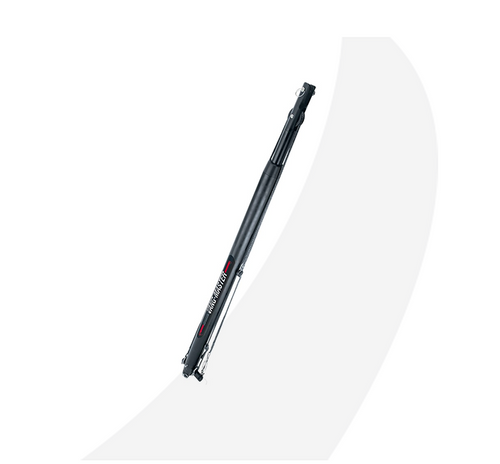
Vang Master Rigid Vang VM8 For Boats 45' To 56' (Closed 72" / Open 84")

Vang Master Rigid Vang VM7 For Boats 45' To 56' (Closed 60" / Open 72")

Vang Master Rigid Vang VM6 For Boats 35' To 46' (Closed 60" / Open 72")
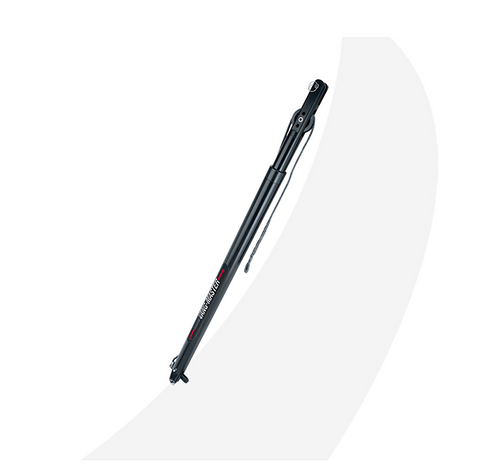
Vang Master Rigid Vang VM5 For Boats 35' To 46' (Closed 48" / Open 60")

Vang Master Rigid Vang VM4 For Boats 26' To 38' (closed 48" / open 58")

Vang Master Rigid Vang VM3 For Boats 26' To 38' (Closed 32" / Open 42")

Vang Master Rigid Vang VM2 For Boats 18' To 28' (closed 40" / open 50")
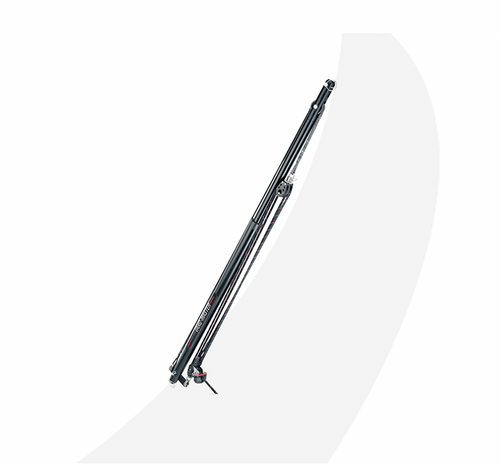
Vang Master Rigid Vang VM1 For Boats 18' To 28' (closed 28" / open 36")

Selden Gas Spring Kit (RodKicker 30/Hard)

Selden Gas Spring Kit (RodKicker 20/Super)

Selden Gas Spring Kit (RodKicker 30/Normal )

Schaefer Boom Vang, 4.1, 1000 Lb (450kg) SWL

Selden Gas Spring Kit (RodKicker 20/Hard)
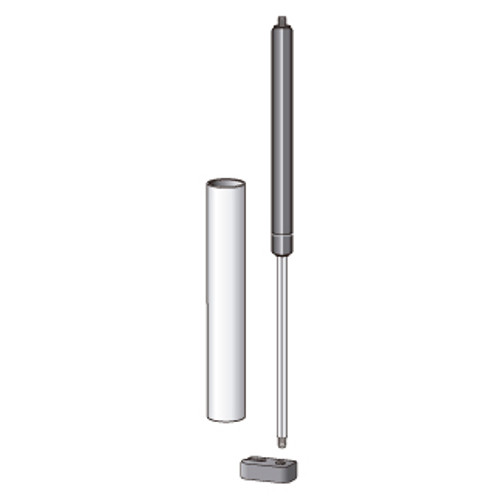
Selden Gas Spring Kit (RodKicker 20/Normal )

Schaefer Boom Vang, 4.1, 900 Lb (410kg) SWL
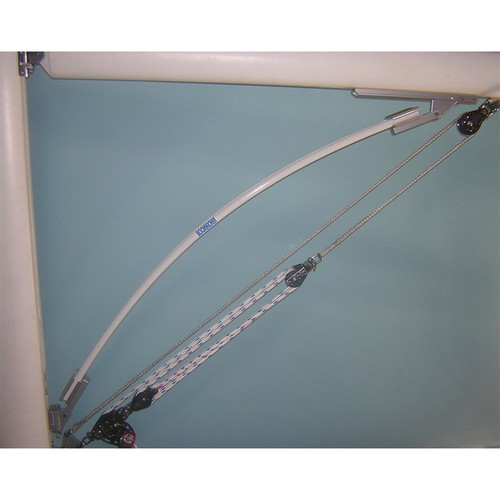
Boomkicker for sailboats 34 to 38' (K01500)

Selden Gas Spring Kit (RodKicker 10/Super)

Boomkicker for sailboats 30 to 34' (K01250)

Boomkicker for sailboats 27 to 30' (K01000)

Boomkicker for sailboats 25 to 27' (K0800)

Please verify you are a human
Access to this page has been denied because we believe you are using automation tools to browse the website.
This may happen as a result of the following:
- Javascript is disabled or blocked by an extension (ad blockers for example)
- Your browser does not support cookies
Please make sure that Javascript and cookies are enabled on your browser and that you are not blocking them from loading.
Reference ID: 9e334a41-e79f-11ee-8315-4edbcd93e1e2
Powered by PerimeterX , Inc.
Free Shipping Over $99* - 366 Day Returns - Dedicated Customer Support

- Call Us +1-503-285-5536
- Sign in & Register
- Recently Viewed
- One Design Parts
- ILCA / Laser Parts
Laser / ILCA Boom Vang Rigging & Parts
Regain control with an upgraded boom vang or replacement vang parts or line for your Laser / ILCA sailboat from the experts at West Coast Sailing. We offer the latest 16:1 class legal vang, the classic 3:1 vang, replica options, pre-cut line, and all the recommended blocks, pins, and fittings.
- Qty in Cart

Laser / ILCA Vang Complete TecPRO (Allen Vang Block)

Laser / ILCA Vang Control PRO

Laser / ILCA Vang Complete TecPRO (Harken Vang Block)
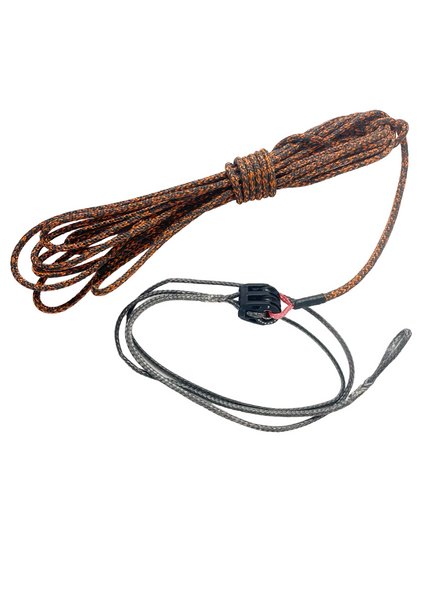
Laser / ILCA Vang Control TecPRO

Laser/ILCA 30mm Extreme High Load Vang Block (Allen)

Ronstan ILCA Vang Key (Curved)

Ronstan ILCA High Load Vang Block (No Key)

Ronstan ILCA High Load Vang Block

ILCA Vang Upgrade Harken XD Base

ILCA Vang Key (Updated)

ILCA Laser Vang Upgrade Harken
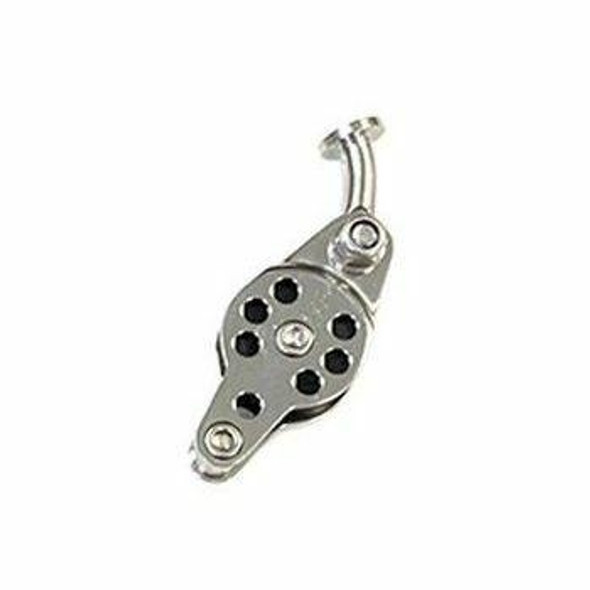
Laser / ILCA Vang Upper Block w/ Key

Harken 19mm Bullseye Fairlead (ILCA Vang Base)

Laser Vang Upgrade 15:1 (Allen)

Laser Lower Vang Block (Allen)

Laser Vang Key (Nautos)
- Total: items /
- Add all to cart
Adding your products to cart
Race / 16:1 Boom Vang System

This is the current vang set up found on most modern Laser / ILCA sailboats, offering a powerful 16:1 cascade system. It features a vang base unit, double block with becket in the center, and a vang block with key at the top end, using a length of 4mm or 5mm control line with a Dyneema/Spectra primary line.
Classic / 3:1 Boom Vang System

This is the vang assembly used on Laser sailboats until 2001. It is a simple 3:1 purchase, using a jam block at the base with a simple turning block with key at the top and a 10 foot length of control line. This set up is great for the casual sailor.
Subscribe To Our Newsletter
Sign up for our newsletter to receive exclusive discounts, new product announcements, and upcoming sales.
- Bahasa Indonesia
- Slovenščina
- Science & Tech
- Russian Kitchen
Cruising the Moskva River: A short guide to boat trips in Russia’s capital

There’s hardly a better way to absorb Moscow’s atmosphere than on a ship sailing up and down the Moskva River. While complicated ticketing, loud music and chilling winds might dampen the anticipated fun, this checklist will help you to enjoy the scenic views and not fall into common tourist traps.
How to find the right boat?
There are plenty of boats and selecting the right one might be challenging. The size of the boat should be your main criteria.
Plenty of small boats cruise the Moskva River, and the most vivid one is this yellow Lay’s-branded boat. Everyone who has ever visited Moscow probably has seen it.

This option might leave a passenger disembarking partially deaf as the merciless Russian pop music blasts onboard. A free spirit, however, will find partying on such a vessel to be an unforgettable and authentic experience that’s almost a metaphor for life in modern Russia: too loud, and sometimes too welcoming. Tickets start at $13 (800 rubles) per person.
Bigger boats offer smoother sailing and tend to attract foreign visitors because of their distinct Soviet aura. Indeed, many of the older vessels must have seen better days. They are still afloat, however, and getting aboard is a unique ‘cultural’ experience. Sometimes the crew might offer lunch or dinner to passengers, but this option must be purchased with the ticket. Here is one such option offering dinner for $24 (1,490 rubles).

If you want to travel in style, consider Flotilla Radisson. These large, modern vessels are quite posh, with a cozy restaurant and an attentive crew at your service. Even though the selection of wines and food is modest, these vessels are still much better than other boats.

Surprisingly, the luxurious boats are priced rather modestly, and a single ticket goes for $17-$32 (1,100-2,000 rubles); also expect a reasonable restaurant bill on top.
How to buy tickets?
Women holding photos of ships promise huge discounts to “the young and beautiful,” and give personal invitations for river tours. They sound and look nice, but there’s a small catch: their ticket prices are usually more than those purchased online.
“We bought tickets from street hawkers for 900 rubles each, only to later discover that the other passengers bought their tickets twice as cheap!” wrote (in Russian) a disappointed Rostislav on a travel company website.
Nevertheless, buying from street hawkers has one considerable advantage: they personally escort you to the vessel so that you don’t waste time looking for the boat on your own.

Prices start at $13 (800 rubles) for one ride, and for an additional $6.5 (400 rubles) you can purchase an unlimited number of tours on the same boat on any given day.
Flotilla Radisson has official ticket offices at Gorky Park and Hotel Ukraine, but they’re often sold out.
Buying online is an option that might save some cash. Websites such as this offer considerable discounts for tickets sold online. On a busy Friday night an online purchase might be the only chance to get a ticket on a Flotilla Radisson boat.
This website (in Russian) offers multiple options for short river cruises in and around the city center, including offbeat options such as ‘disco cruises’ and ‘children cruises.’ This other website sells tickets online, but doesn’t have an English version. The interface is intuitive, however.
Buying tickets online has its bad points, however. The most common is confusing which pier you should go to and missing your river tour.

“I once bought tickets online to save with the discount that the website offered,” said Igor Shvarkin from Moscow. “The pier was initially marked as ‘Park Kultury,’ but when I arrived it wasn’t easy to find my boat because there were too many there. My guests had to walk a considerable distance before I finally found the vessel that accepted my tickets purchased online,” said the man.
There are two main boarding piers in the city center: Hotel Ukraine and Park Kultury . Always take note of your particular berth when buying tickets online.
Where to sit onboard?
Even on a warm day, the headwind might be chilly for passengers on deck. Make sure you have warm clothes, or that the crew has blankets ready upon request.
The glass-encased hold makes the tour much more comfortable, but not at the expense of having an enjoyable experience.

Getting off the boat requires preparation as well. Ideally, you should be able to disembark on any pier along the way. In reality, passengers never know where the boat’s captain will make the next stop. Street hawkers often tell passengers in advance where they’ll be able to disembark. If you buy tickets online then you’ll have to research it yourself.
There’s a chance that the captain won’t make any stops at all and will take you back to where the tour began, which is the case with Flotilla Radisson. The safest option is to automatically expect that you’ll return to the pier where you started.
If using any of Russia Beyond's content, partly or in full, always provide an active hyperlink to the original material.
to our newsletter!
Get the week's best stories straight to your inbox
- What to do in Moscow City, if you’re not mega-rich
- Moscow after dusk: 10 places to drink, dance, and groove
- 5 things you must do in Moscow in 2018 between football matches (or without them)
- Sandwiched between Moscow and St. Petersburg: How to spend a perfect weekend in Tver
- 24 or 48 hours in Moscow: Where to go and what to do in 2019
This website uses cookies. Click here to find out more.

The Comprehensive Guide to Moscow Nightlife
- Posted on April 14, 2018 July 26, 2018
- by Kings of Russia
- 8 minute read

Moscow’s nightlife scene is thriving, and arguably one of the best the world has to offer – top-notch Russian women, coupled with a never-ending list of venues, Moscow has a little bit of something for everyone’s taste. Moscow nightlife is not for the faint of heart – and if you’re coming, you better be ready to go Friday and Saturday night into the early morning.
This comprehensive guide to Moscow nightlife will run you through the nuts and bolts of all you need to know about Moscow’s nightclubs and give you a solid blueprint to operate with during your time in Moscow.
What you need to know before hitting Moscow nightclubs
Prices in moscow nightlife.
Before you head out and start gaming all the sexy Moscow girls , we have to talk money first. Bring plenty because in Moscow you can never bring a big enough bankroll. Remember, you’re the man so making a fuzz of not paying a drink here or there will not go down well.
Luckily most Moscow clubs don’t do cover fees. Some electro clubs will charge 15-20$, depending on their lineup. There’s the odd club with a minimum spend of 20-30$, which you’ll drop on drinks easily. By and large, you can scope out the venues for free, which is a big plus.
Bottle service is a great deal in Moscow. At top-tier clubs, it starts at 1,000$. That’ll go a long way with premium vodka at 250$, especially if you have three or four guys chipping in. Not to mention that it’s a massive status boost for getting girls, especially at high-end clubs.
Without bottle service, you should estimate a budget of 100-150$ per night. That is if you drink a lot and hit the top clubs with the hottest girls. Scale down for less alcohol and more basic places.
Dress code & Face control
Door policy in Moscow is called “face control” and it’s always the guy behind the two gorillas that gives the green light if you’re in or out.
In Moscow nightlife there’s only one rule when it comes to dress codes:
You can never be underdressed.
People dress A LOT sharper than, say, in the US and that goes for both sexes. For high-end clubs, you definitely want to roll with a sharp blazer and a pocket square, not to mention dress shoes in tip-top condition. Those are the minimum requirements to level the playing field vis a vis with other sharply dressed guys that have a lot more money than you do. Unless you plan to hit explicit electro or underground clubs, which have their own dress code, you are always on the money with that style.
Getting in a Moscow club isn’t as hard as it seems: dress sharp, speak English at the door and look like you’re in the mood to spend all that money that you supposedly have (even if you don’t). That will open almost any door in Moscow’s nightlife for you.
Types of Moscow Nightclubs
In Moscow there are four types of clubs with the accompanying female clientele:
High-end clubs:
These are often crossovers between restaurants and clubs with lots of tables and very little space to dance. Heavy accent on bottle service most of the time but you can work the room from the bar as well. The hottest and most expensive girls in Moscow go there. Bring deep pockets and lots of self-confidence and you have a shot at swooping them.
Regular Mid-level clubs:
They probably resemble more what you’re used to in a nightclub: big dancefloors, stages and more space to roam around. Bottle service will make you stand out more but you can also do well without. You can find all types of girls but most will be in the 6-8 range. Your targets should always be the girls drinking and ideally in pairs. It’s impossible not to swoop if your game is at least half-decent.
Basic clubs/dive bars:
Usually spots with very cheap booze and lax face control. If you’re dressed too sharp and speak no Russian, you might attract the wrong type of attention so be vigilant. If you know the local scene you can swoop 6s and 7s almost at will. Usually students and girls from the suburbs.
Electro/underground clubs:
Home of the hipsters and creatives. Parties there don’t mean meeting girls and getting drunk but doing pills and spacing out to the music. Lots of attractive hipster girls if that is your niche. That is its own scene with a different dress code as well.

What time to go out in Moscow
Moscow nightlife starts late. Don’t show up at bars and preparty spots before 11pm because you’ll feel fairly alone. Peak time is between 1am and 3am. That is also the time of Moscow nightlife’s biggest nuisance: concerts by artists you won’t know and who only distract your girls from drinking and being gamed. From 4am to 6am the regular clubs are emptying out but plenty of people, women included, still hit up one of the many afterparty clubs. Those last till well past 10am.
As far as days go: Fridays and Saturdays are peak days. Thursday is an OK day, all other days are fairly weak and you have to know the right venues.
The Ultimate Moscow Nightclub List
Short disclaimer: I didn’t add basic and electro clubs since you’re coming for the girls, not for the music. This list will give you more options than you’ll be able to handle on a weekend.
Preparty – start here at 11PM
Classic restaurant club with lots of tables and a smallish bar and dancefloor. Come here between 11pm and 12am when the concert is over and they start with the actual party. Even early in the night tons of sexy women here, who lean slightly older (25 and up).
The second floor of the Ugolek restaurant is an extra bar with dim lights and house music tunes. Very small and cozy with a slight hipster vibe but generally draws plenty of attractive women too. A bit slower vibe than Valenok.
Very cool, spread-out venue that has a modern library theme. Not always full with people but when it is, it’s brimming with top-tier women. Slow vibe here and better for grabbing contacts and moving on.

High-end: err on the side of being too early rather than too late because of face control.
Secret Room
Probably the top venue at the moment in Moscow . Very small but wildly popular club, which is crammed with tables but always packed. They do parties on Thursdays and Sundays as well. This club has a hip-hop/high-end theme, meaning most girls are gold diggers, IG models, and tattooed hip hop chicks. Very unfavorable logistics because there is almost no room no move inside the club but the party vibe makes it worth it. Strict face control.
Close to Secret Room and with a much more favorable and spacious three-part layout. This place attracts very hot women but also lots of ball busters and fakes that will leave you blue-balled. Come early because after 4am it starts getting empty fast. Electronic music.
A slightly kitsch restaurant club that plays Russian pop and is full of gold diggers, semi-pros, and men from the Caucasus republics. Thursday is the strongest night but that dynamic might be changing since Secret Room opened its doors. You can swoop here but it will be a struggle.

Mid-level: your sweet spot in terms of ease and attractiveness of girls for an average budget.
Started going downwards in 2018 due to lax face control and this might get even worse with the World Cup. In terms of layout one of the best Moscow nightclubs because it’s very big and bottle service gives you a good edge here. Still attracts lots of cute girls with loose morals but plenty of provincial girls (and guys) as well. Swooping is fairly easy here.
I haven’t been at this place in over a year, ever since it started becoming ground zero for drunken teenagers. Similar clientele to Icon but less chic, younger and drunker. Decent mainstream music that attracts plenty of tourists. Girls are easy here as well.
Sort of a Coyote Ugly (the real one in Moscow sucks) with party music and lots of drunken people licking each others’ faces. Very entertaining with the right amount of alcohol and very easy to pull in there. Don’t think about staying sober in here, you’ll hate it.
Artel Bessonitsa/Shakti Terrace
Electronic music club that is sort of a high-end place with an underground clientele and located between the teenager clubs Icon and Gipsy. Very good music but a bit all over the place with their vibe and their branding. You can swoop almost any type of girl here from high-heeled beauty to coked-up hipsters, provided they’re not too sober.
Afterparty: if by 5AM you haven’t pulled, it’s time to move here.
Best afterparty spot in terms of trying to get girls. Pretty much no one is sober in there and savage gorilla game goes a long way. Lots of very hot and slutty-looking girls but it can be hard to tell apart who is looking for dick and who is just on drugs but not interested. If by 9-10am you haven’t pulled, it is probably better to surrender.
The hipster alternative for afterparties, where even more drugs are in play. Plenty of attractive girls there but you have to know how to work this type of club. A nicer atmosphere and better music but if you’re desperate to pull, you’ll probably go to Miks.
Weekday jokers: if you’re on the hunt for some sexy Russian girls during the week, here are two tips to make your life easier.
Chesterfield
Ladies night on Wednesdays means this place gets pretty packed with smashed teenagers and 6s and 7s. Don’t pull out the three-piece suit in here because it’s a “simpler” crowd. Definitely your best shot on Wednesdays.
If you haven’t pulled at Chesterfield, you can throw a Hail Mary and hit up Garage’s Black Music Wednesdays. Fills up really late but there are some cute Black Music groupies in here. Very small club. Thursday through Saturday they do afterparties and you have an excellent shot and swooping girls that are probably high.
Shishas Sferum
This is pretty much your only shot on Mondays and Tuesdays because they offer free or almost free drinks for women. A fairly low-class club where you should watch your drinks. As always the case in Moscow, there will be cute girls here on any day of the week but it’s nowhere near as good as on the weekend.

In a nutshell, that is all you need to know about where to meet Moscow girls in nightlife. There are tons of options, and it all depends on what best fits your style, based on the type of girls that you’re looking for.
Related Topics
- moscow girls
- moscow nightlife

The Top 3 Cities in Ukraine for First Timers
- Posted on July 7, 2018 August 4, 2019
You May Also Like

- Uncategorized
The Best Expat Blogs for Moscow
- Posted on May 31, 2020 June 1, 2020

Finding a Russian Bride: How and Where to Meet Her
- Posted on August 9, 2019 August 9, 2019

Meeting Women in Moscow: Dating Perspectives on the World’s Most Beautiful Women
- Posted on August 5, 2019 August 9, 2019

Meeting Russian Women: Top 5 Locations
- Posted on August 3, 2019 June 1, 2020

Moscow vs St. Petersburg – Which One to Visit?
- Posted on July 31, 2019 August 3, 2019

Hot Russian Girls – Where to Find & Date Them
- Posted on March 30, 2019 March 30, 2019
A Guide to Teaching English in Russia
- Posted on August 11, 2018 October 9, 2019

How to Attract Russian Girls
- Posted on July 15, 2018 August 4, 2019
Leave a Reply Cancel reply
Your email address will not be published. Required fields are marked *
Input your search keywords and press Enter.
- Hispanoamérica
- Work at ArchDaily
- Terms of Use
- Privacy Policy
- Cookie Policy
Moscow's High Rise Bohemia: The International Business District With No Business

- Written by Dario Goodwin
- Published on March 17, 2015
The Moscow International Business Center (Also known as Moskva-City ) was meant to be Russia ’s ticket into the Western world. First conceived in 1992, the district at the edge of Moscow’s city center is intended to contain up to 300,000 inhabitants, employees and visitors at any given moment and, when completed, will house over 4 million square meters of prime retail, hotel and office space to create what the Russian government desired most from this project: an enormous financial district that could dwarf London’s Canary Wharf and challenge Manhattan . Twenty three years later though, Moscow-based real estate company Blackwood estimates that as much as 45% of this new space is entirely vacant and rents have plummeted far below the average for the rest of Moscow. The only press Moskva-City is attracting is for tenants like the High Level Hostel , a hostel catering to backpackers and other asset-poor tourists on the 43rd floor of the Imperia Tower , with prices starting at $25.50 for a bed in a six-person room. This is not the glittering world of western high finance that was envisioned back in the post-Soviet 90s; but what has it become instead?

As one might expect from a project of this sheer ambition, Moskva-City has a troubled past. The economic crash in 2008 hit Russia hard enough to evict the previous Mayor of Moscow , Yuri Luzhkov, who had been a cheerleader for the district, and replace him with the considerably more austere Sergei Sobyanin, who famously declared that the whole idea was an “urban planning mistake.” But as recently as 2013, the Wall Street Journal was triumphantly claiming that Moskva-City had risen from the dead, citing 80% occupancy rates and glowing quotes from industry insiders claiming that Moskva-City was the "place to be." Driven by record highs in oil prices, Moscow looked poised to become the next Dubai .
Instead, Moscow is now in the grip of an economic winter prompted by western sanctions and drops in the price of oil. The large financial groupings that Moskva-City was meant to shelter have been warned off by their inability to issue credit to international markets, for example - but Moskva-City isn’t just an Empire State Building left empty by the Great Depression.
A fundamental problem that is holding Moskva back compared to the rest of Moscow is the simple fact that currently, getting to Moskva-City is nigh-on impossible at peak hours. Moscow has long been plagued with transport problems, ever since the government failed to match the dramatic expansion of the city with a dramatic expansion of the transport system after the Second World War. Despite being only 2.5 miles from the Kremlin , Moskva-City is only just inside the ring road that bounds the city center and which acts as the only real transport link to it (and as a result, is clogged by construction vehicles.) A railway and metro hub has been finished, but so far only runs a one-stop shuttle service to the closest Metro station that is actually integrated with the rest of Moscow Metro. The isolation of the outer districts is a large, negative part of the Moscow psyche, and it’s not surprising that this is driving away the globetrotting financial elite this project was meant to attract.

The project is managed by architectural practice No.6, which is a constituent part of the large Moscow based practice Mosproject-2 , which is itself a public corporation headed up by Mikhail Vasilyevich Posokhin, who is apparently the “People’s Architect of Russia.” Despite all this state involvement, the project has still managed to become bogged down in bureaucratic infighting - each lot is managed and developed individually, which has led to developers competing for occupants by slashing rates.
Much has been written about the way modern financial districts and towers that inhabit them can be unwelcoming, forbidding or even hostile by design, but the skyscrapers of Moskva-City seem even less friendly than usual. The site - a former stone quarry, chosen out of necessity as the only place in the city center where a new district could be plausibly constructed - is isolated both physically and visually, leaving the cluster a stark anomaly on the city skyline. Even the names seem more imposing than optimistic now: Imperia, City of Capitals , Steel Peak.

The Mercury City Tower , so far the tallest completed building on the site, is officially “a strong reference to Russian constructivism, [which] gives the tower a strong vertical thrust similar to the one found in New York's Chrysler building .” It would be easy to criticize the Mercury City Tower for picking ‘inspirations’ that are so totally opposed to each other - The Chrysler building the defining emblem of American pre-crash confidence and Constructivism created with the express purpose (especially architecturally) of extending the Bolshevik revolution into a social revolution - but the way they smash those two inspirations together is almost beautifully ironic.

Even though the High Level Hostel is less an asset to a financial district than it is a PR problem, it’s been a huge success since opening in September, already ranked 27th out of 766 hostels in Moscow by TripAdvisor. According to the management agency for Moskva-City , 58% of the new occupant signings this year have been non-financial, including a number of small to medium size businesses. Other areas of office space have been occupied by a restaurant and a culinary school, while another space has been redeveloped into a 6,000 seat theater.
While Moskva-City is failing to be a financial district that could take on the world, it’s inadvertently becoming a humanized space catering to the very groups that the Russian economic miracle left behind. Taking advantage of rents lower than the rest of Moscow , the world class facilities and the sheer desperation of the developers, the humanization of Moskva-City could well create the world’s first high-rise bohemia.

Of course, these are not spaces designed for a community, or even for people: these are spaces designed for money, and there’s little scope for changing something that seems so baked into the design of Moskva-City . The High Level Hostel is trading off of the irony of being a hostel in a banking tower, but it’s perfectly possible that at some point people will no longer find this joke funny (especially in a building that seems hostile to the very idea of humor). The isolation of Moskva, even though it allowed this community to spring up in the first place, is just as detrimental to a humanized district as it is to a financial one: even bohemians need to move around the city, or the district risks becoming a black-spot instead of a hot-spot.
Moskva-City’s isolation won’t last forever. The end of construction will open the roads up to traffic, and plans to properly integrate the spur lines of the Metro in this area into the wider system are well under way. The integration of the district will inevitably push up rents, and the Russian economy will eventually boom once again. When that happens, Moskva-City is prime territory to be reconquered by the giants of international finance, and it seems unlikely that the municipal or national governments would want to step in to protect this accidental district. For now, though, the towers capture perfectly this moment of Russia ’s schizophrenic understanding of its place in the world.
- Sustainability
世界上最受欢迎的建筑网站现已推出你的母语版本!
想浏览archdaily中国吗, you've started following your first account, did you know.
You'll now receive updates based on what you follow! Personalize your stream and start following your favorite authors, offices and users.

- About ParkNews
- Privacy Policy
FEIG ELECTRONIC: Moscow-City Skyscrapers Streamline Parking Access and Control with Secure RFID
Feig electronic partners with isbc group to deploy ucode dna rfid security and parking access control solution in moscow business district.
Weilburg, Germany — December 3, 2019 — FEIG ELECTRONIC , a leading global supplier of radio frequency identification (RFID) readers and antennas with fifty years of industry experience, announces deployment of the UCODE DNA RFID security and parking contactless identification solution in the Moscow International Business Center, known as Moscow-City, one of the world’s largest business district projects.
The management of Moscow-City not only selected long-range, passive UHF RFID to implement in its controlled parking areas, it also chose to implement UCODE DNA , the highest form of secure RAIN RFID technology, developed by NXP Semiconductors.

Panoramic view of Moscow city and Moskva River at sunset. New modern futuristic skyscrapers of Moscow-City – International Business Center, toned
“Underscoring NXP’s innovation and leadership in developing advanced RAIN RFID technologies, our UCODE DNA was chosen to be incorporated with the FEIG and ISBC implementation of the contactless identification system in the prestigious Moscow-City,” said Mahdi Mekic, marketing director for RAIN RFID with NXP Semiconductors. “This exciting project represents yet another successful deployment of NXP’s contactless portfolio, and showcases our continued ability to meet the high-security requirements of highly demanding applications without compromising user convenience.”
“UCODE DNA is considered the only identification technology to match the physical protection of a barrier with the cybersecurity necessary to truly protect entrances from unauthorized access,” said Manuel Haertlé, senior product manager for FEIG Electronic. “As a respected contactless payment technology company, FEIG applies security know-how from its payment terminals, which are fully certified according to the latest high-class security standards, into our RFID systems. FEIG vehicle access control RFID readers incorporate advanced secure key storage elements, supporting various methods for secure key injection.”
FEIG’s partner ISBC Group provided the knowledge and support for this successful implementation using FEIG’s long-range UHF RFID . The resulting system enables authorized vehicle entry into areas reserved for private residential use or corporate tenants, while also allowing availability of temporary, fee-based visitor parking. Thanks to the cryptographic authentication of UCODE DNA, both the tag and reader must go through an authentication procedure before the reader will validate the data from the tag, which is transmitted wirelessly. This level of authentication is typically used in the most secure data communication networks.
“The system’s two-step authentication means that only authorized equipment can handle the secure protocol and the data exchange with the UCODE DNA based tag. Without the required cryptographic secrets, other readers would query the tag in vain, because the tag’s response cannot be interpreted or understood,” said Andrey Krasovskiy, director of the RFID department at ISBC Group. “On top of this, each data exchange in the authentication process is unique, so even if a malicious actor were to intercept the communication, the transmission is only good for a single exchange and the tag’s unique identity is protected from cloning.”
Established in 1992 and still growing, Moscow-City is the revitalization and transformation of an industrial riverfront into a new, modern, vibrant and upscale business and residential district. A mix of residential, hotel, office, retail and entertainment facilities, it is located about four kilometers west of Red Square along the Moscow River. Twelve of the twenty-three planned facilities have already been completed, with seven currently under construction. Six skyscrapers in Moscow-City reach a height of at least 300 meters, including Europe’s tallest building, Federation Tower, which rises more than 100 stories.
Partnering with ISBC and deploying FEIG Electronic RFID solutions, the Moscow International Business Center is delivering security and access control to its city center today, as it grows into the city of tomorrow.
About FEIG ELECTRONIC
FEIG ELECTRONIC GmbH, a leading global supplier of RFID readers and antennas is one of the few suppliers worldwide offering RFID readers and antennas for all standard operating frequencies: LF (125 kHz), HF (13.56 MHz), UHF (860-960 MHz). A trusted pioneer in RFID with more than 50 years of industry experience, FEIG ELECTRONIC delivers unrivaled data collection, authentication, and identification solutions, as well as secure contactless payment systems. Readers from FEIG ELECTRONIC, which are available for plug-in, desktop, and handheld applications, support next-generation contactless credit cards, debit cards, smart cards, NFC and access control credentials to enable fast, accurate, reliable and secure transactions. For more information, visit: www.feig.de/en
Founded in Moscow in 2002, ISBC Group provides knowledge and support to integrators for their successful implementation of RFID and smart card-based solutions. The company specializes in the distribution of smart card equipment, contact and contactless card manufacturing, smart card and RFID personalization services, and information security. Its Research and Design Center is focused specifically on RFID, primarily HF and UHF solutions with NXP tags, and software development for the smart card industry. For more information visit: https://isbc-cards.com/
← Previous Post
Next Post →
Privacy Overview

IMAGES
VIDEO
COMMENTS
June 15, 2022. A boom vang is a set of blocks and lines or an adjustable pole used to pull the boom down and shape the sail. The boom vang (or "kicking strap") is a system used to control the shape of the sail. It counteracts the upward force of the boom jack and the mainsail by pulling the boom downward. This results in the ability to ...
The vang allows vertical adjustment of the boom, and is an extremely important tool to shape the main for speed. Tension the vang to tighten the leech, flatten the sail and bend the mast. Cruisers use the vang to keep the boom from rising when sailing downwind and abraiding the main. Typical boat length: Small Boat: 22' - 28' (6.7 - 8.5 m)
The Boom Vang, in its simplest form, is a block and tackle arranged in such a fashion that it applies downward force (also upward force, see rigid vang) to the boom. This will allow the sailor to control the tension of the leech at all points of sail, regardless of the boom's sheet tension. Although more purchase may be necessary, typically ...
A boom vang (US) or kicking strap (UK) (often shortened to "vang" or "kicker") is a line or piston system on a sailboat used to exert downward force on the boom and thus control the shape of the sail. The Collins English Dictionary defines it as "A rope or tackle extended from the boom of a fore-and-aft mainsail to a deck fitting of a vessel ...
The Vang. Boom vangs provide essential safety and twist control for sailboat mainsails. This article includes explanations and some helpful diagrams to inspire do-it-yourself riggers to design a system that works for them. Cascading block and tackle system: 2:1 wire or single-braid line cascade with 4:1 fiddle block & tackle. 2 x 2 x 2 x 4 = 32 ...
The vang will pull down on the boom and maintain a good upper leech angle, reducing luffing. When you come up to the wind, to 40-70 degrees apparent, the vang can still be in play. If you eventually do ease the mainsheet and traveler to adjust for any reason without touching the vang, the top of the main will twist off.
This size Ocean Vang retails for $279, which includes the control line, but not the brackets for the mast ($39) or boom ($42). The vang carries a one-year warranty. Conclusions. For cruising sailors, it's most important that a rigid vang works to support the boom and secondarily to trim the mainsail.
The boom vang can be a misunderstood sail control. It takes over the job of pulling down on the boom once the mainsheet is eased. Upwind, the mainsheet pulls down as soon as the boom is over the traveler. ... If you don't use the boom vang in all but the lightest conditions, the boom will rise up as it is eased out and the sail will twist off ...
Installation instructions. To install a boom vang on a C-22 or similar sailboat: 1. The vang should be installed at a 45 degree angle between the mast and boom. Measure the height of the top of the boom above the cabin roof with the mainsail at full hoist. For a Catalina 22, it should be 39″. 2.
Using the Boom Vang: Advanced Sailing Video Lessons. Part of the series: Advanced Sailing Lessons. Learn how to use the boom vang in this free video on saili...
On an upwind leg, especially if you're overpowered, tighten the vang to depower the main by flattening the sail. On the downwind side of life, before you bear away, ease the vang — this will make the mainsail fuller. Then trim the main so the top batten of the sail is parallel with the boom. That's an extremely basic overview, but the ...
Let the sail bag out some. When sailing downwind in a strong wind, ease the vang to depower the mainsail by allowing the boom to rise and the sail to spill air high up (mainsail "twist"). Bring in the mainsheet if needed to prevent chafing of the sail against the shrouds and spreaders. After dropping the mainsail, raise the boom to give ...
A boom vang or kicking strap on a sailboat used to exert downward force on the boom and thus control the shape of the sail. Boom vangs helps control boom height which determines twist, or the shape of the mainsail leech during different wind conditions. Sailboat Block & Tackle sets come with both of the blocks and a cleat to create a full boom ...
Boom Vangs. Hydraulic vangs change the height of the boom to help control sail shape. They also function as a topping lift to hold the boom up when reefing, and to keep it level when the sail is flaked. Harken offers a full range of vang cylinders. The HYCV single-acting gas return is the standard vang used for most boats up to approximately 23 ...
A large bowline loop (the red striped line) affixes the preventer to the boom. The knot can be reached without sheeting the boom in to the boat. If this is not the case then a large bowline loop ...
Boom vangs from Vela at the best price. One design or custom built available. Boomkicker, Vang Master, and Schaefer. The best boomvangs from Vela.
1-15 results of 15. Fisheries Supply is your premier supplier of rigid boom vangs from top brands. We offer a full range of quality boom vangs for sailboats, including the Rodkicker from Selden, the Yacht Rod from Forspar or the Boomkicker - all rigid vangs. We also stock a variety of boom vang hardware and parts - everything you need to ...
Boat vangs generally consist of a block and tackle system designed to pull the boom down. Rigid vangs also include block and tackle systems to pull the boom down, but also hold the boom up in place of a topping lift. Boomkickers also act as boom supports and eliminate the need for a topping lift. They are designed for installation on boats that ...
Classic / 3:1 Boom Vang System. This is the vang assembly used on Laser sailboats until 2001. It is a simple 3:1 purchase, using a jam block at the base with a simple turning block with key at the top and a 10 foot length of control line. This set up is great for the casual sailor. Regain control with an upgraded boom vang or replacement vang ...
Prices start at $13 (800 rubles) for one ride, and for an additional $6.5 (400 rubles) you can purchase an unlimited number of tours on the same boat on any given day.
Dress code & Face control. Door policy in Moscow is called "face control" and it's always the guy behind the two gorillas that gives the green light if you're in or out. In Moscow nightlife there's only one rule when it comes to dress codes: You can never be underdressed. People dress A LOT sharper than, say, in the US and that goes ...
The Moscow International Business Center (Also known as Moskva-City) was meant to be Russia 's ticket into the Western world. First conceived in 1992, the district at the edge of Moscow's city ...
"Underscoring NXP's innovation and leadership in developing advanced RAIN RFID technologies, our UCODE DNA was chosen to be incorporated with the FEIG and ISBC implementation of the contactless identification system in the prestigious Moscow-City," said Mahdi Mekic, marketing director for RAIN RFID with NXP Semiconductors.